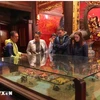A number of new modern flower markets and villages in Hanoi with different trading methods have bloomed in recent years to replace the old ones. However, they all still hold their own bustling atmosphere as they did the old days.
In previous time, Hanoi ’s flowers markets were located inside the old narrow area of Hang Luoc Street with houses with moss-covered roofs and the sounds of the whistles from trains passing at night.
Nowadays, Hanoi’s flower markets have moved to the wider streets of Au Co, Nghi Tam and Nhat Tan, which are crowded with visitors out walking, riding bicycles, motorbikes or in their cars to enjoy the beauty and aroma of the various kinds of flowers.
In the 40-70 of the 20 th century, Ngoc Ha flower village, a popular centre for flora in Hanoi , became famous all around Hanoi as it could ensure a sufficient supply of flowers for citizens living in the Old Quarter. Moreover, it was also one of the thirteen villages that encompassed the West Lake , which produces the basic necessities for Thang Long Royal Citadel in the past.
While excavating Thang Long Royal Citadel, archaeologists came across the remains of a small river running under the Citadel to Ngoc Ha village.
The river bears the name of the Ngoc river, after which Ngoc Ha village is named.
The industrialisation and reduction in size of the old flower-growing villages such as Ngoc Ha, Nhat Tan, Phu Thuong and Tu Lien, with the construction of new villas and new urban areas have made many people feel they have lost a great asset.
The biggest flower market in Hanoi , now is housed in Quang Ba district and is open every day from early in the morning until midnight, selling various kinds of seasonal flowers. The market is full of peach blossom in spring, fragrant lotus in summer, daisies in autumn and apricot blossom in winter.
Nowadays, wandering about the flower markets to buy beautiful flowers is a popular pleasure for Hanoians, especially before the Tet Holiday.
Subsequently, the end of the flower trade in Ngoc Ha has helped several other flower villages on the outskirts of Hanoi to flourish. They are Kim Chung, Van Tri and Uy No in Dong Anh district, Tay Tuu and Dai Mo in Tu Liem district, Dong Du, Bac Bien and Yen Vien in Gia Lam district./.
In previous time, Hanoi ’s flowers markets were located inside the old narrow area of Hang Luoc Street with houses with moss-covered roofs and the sounds of the whistles from trains passing at night.
Nowadays, Hanoi’s flower markets have moved to the wider streets of Au Co, Nghi Tam and Nhat Tan, which are crowded with visitors out walking, riding bicycles, motorbikes or in their cars to enjoy the beauty and aroma of the various kinds of flowers.
In the 40-70 of the 20 th century, Ngoc Ha flower village, a popular centre for flora in Hanoi , became famous all around Hanoi as it could ensure a sufficient supply of flowers for citizens living in the Old Quarter. Moreover, it was also one of the thirteen villages that encompassed the West Lake , which produces the basic necessities for Thang Long Royal Citadel in the past.
While excavating Thang Long Royal Citadel, archaeologists came across the remains of a small river running under the Citadel to Ngoc Ha village.
The river bears the name of the Ngoc river, after which Ngoc Ha village is named.
The industrialisation and reduction in size of the old flower-growing villages such as Ngoc Ha, Nhat Tan, Phu Thuong and Tu Lien, with the construction of new villas and new urban areas have made many people feel they have lost a great asset.
The biggest flower market in Hanoi , now is housed in Quang Ba district and is open every day from early in the morning until midnight, selling various kinds of seasonal flowers. The market is full of peach blossom in spring, fragrant lotus in summer, daisies in autumn and apricot blossom in winter.
Nowadays, wandering about the flower markets to buy beautiful flowers is a popular pleasure for Hanoians, especially before the Tet Holiday.
Subsequently, the end of the flower trade in Ngoc Ha has helped several other flower villages on the outskirts of Hanoi to flourish. They are Kim Chung, Van Tri and Uy No in Dong Anh district, Tay Tuu and Dai Mo in Tu Liem district, Dong Du, Bac Bien and Yen Vien in Gia Lam district./.



















